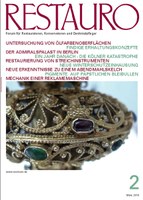RESTAURO Article publication
Crack repairs in string instruments must not only be carried out as gently as possible, but the repair must also reliably withstand the high stresses to which a musical instrument is exposed during playing, as the instruments, as extremely complex systems, react to the smallest changes. During the restoration of an Italian cello from the 18th century, the author Alexis Schilbach presented the possibility of securing glued cracks while at the same time minimizing the influence on the vibrational behavior of the instrument. "1"
The author Alexis Schilbach, based in Switzerland, is a master violin maker and restorer of musical instruments. His co-author Tilman Gruenewald is a student in the fourth semester of the undergraduate course in wood technology and wood construction at the (University of Applied Science) Fachhochschule Salzburg.
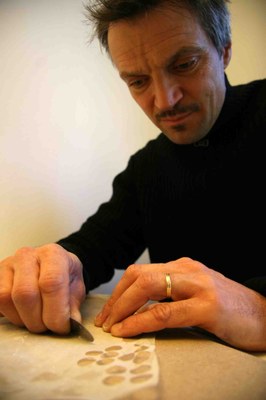
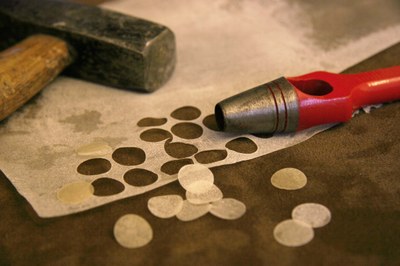
Left picture: Fig. 1: The author scrapes the parchment with the cabinet scraper to a thickness of 0.1mm.
Right picture: Fig. 2: Punching the parchment cover with a hole punch.
Crack covering
Repairing cracks with coverings is a technique that has been used for a long time in stringed instrument repair. Valuable violins and cellos from the classical Italian period (16th - 18th century) often show a large number of wooden plates of different sizes, thickness and types of wood which were applied during several reparation processes. Following careful removal of the instrument belly, wooden crack covers were also seen in the cello, which was entrusted for restoration to the author (fig. 3 + 6). The wood covers are attached to the inside of glued cracks, or cemented over the burrow networks of wood pests. The different wood dyes show that these repairs sometimes date very far back (to the 19th century), but there are also covers with a light wood color, which indicate that the covers are only a few years old. In fact, the author knows from the exchange of experiences with colleagues, that this method of assessing repaired cracks is currently practiced in many violin maker workshops.
Are crack coverings necessary? What are the disadvantages?
Crack covers can be useful if they increase the reliability of the glued crack, as will be explained in this article. Crack covers are especially important at the end of the cracks, where individual wood fibers are damaged, but the crack is not sufficiently open to allow glue to penetrate deeply. The author saw that in areas with dated repaired cracks, new hairline cracks can form, these can open up as new cracks under light pressure, or when they receive dirt and dust.
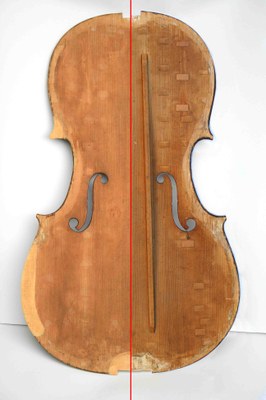
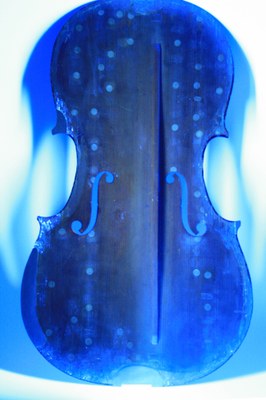
Left picture: Fig. 3 (right side): The interior view of the cello belly after opening the cello / Fig. 4 (left side): The interior view of the cello belly after restoration: the cracks were cleaned, glued and covered with parchment. Two severely damaged marginal areas were filled.
Right picture: Fig. 5: Same View as Fig. 4 under UV light. The parchment covers are clearly visible.
There are however, a number of concerns related to the widespread technique of securing glued cracks with wood coverings. Based on the author's experience, these are as follows:
- In many cases, the bellies were covered with a large number of wooden covers of varying quality and age. In this documented example, there were 42 covers (Fig. 1). One wooden cover which is not perfectly seated or detached from the edge is sufficient to produce a rattling sound, often at only one frequency and at a certain humidity, when playing the instrument. In this case it is impossible for the violin maker to identify and correct the sound source. These sub-noises are an enormous burden for musicians, who must rely on their instrument in concert situations. Wooden boards stiffen a small area of the belly or the back, which changes the vibratory behavior. This should be avoided as it has an influence on the tone of the violin. In the case of a large number of wooden coverings in a section of the belly or back, the change is so enormous that the reinforcement can be felt with a slight bending of the belly, a widespread test method in violin making.
- Additional mass is applied by the wooden crack covers. For a vibrating plate, such as a cello belly, it implies a higher inertia. FT = m · a, meaning that the inertial force is equal to the mass times the acceleration. The acceleration depends on the frequency and the amplitude at which the plate oscillates. At the same frequency and amplitude, a doubling of the inertial force occurs when the mass of the plate is doubled. This affects the musician, as he must take a more labored approach to playing. The 42 wooden crack covers of the documented cello belly, have a total mass of almost 4 grams, which is on the order of 1% of the mass of cello belly. This value is based on the mass of 0.09 grams per average cello wood cover determined in this article.
- The wooden covers change the appearance of the covered surface. It must be the goal of every restorer that his intervention remains detectable, but also that the appearance of the restored object is affected as little as possible.
Why were cracks repaired almost exclusively with wood?
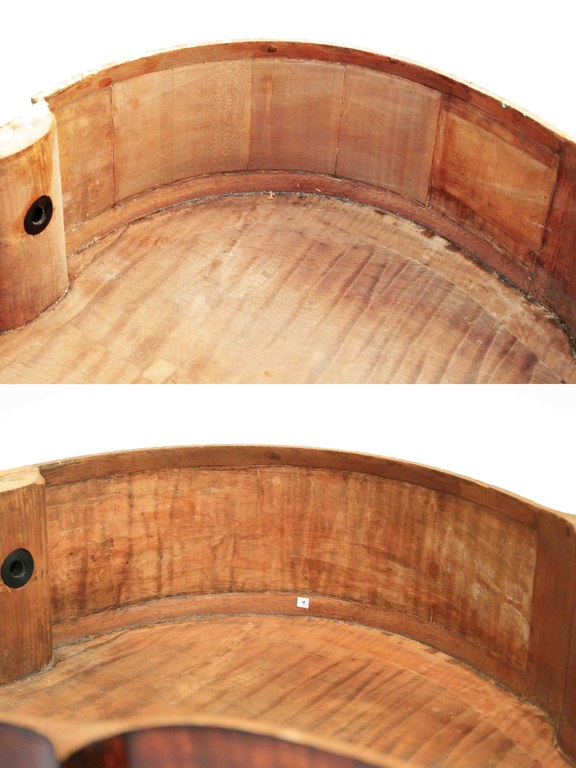
Fig. 6: Interior view of the bottom ribs. Above image: with wooden covers before restoration. Below image: with parchment coverings after restoration.
Until the beginning of the 1970s, wood was the preferred material in all violin restoration workshops, which up to this time were usually also violin building workshops. The basics of the craft, which were learned during the apprenticeship, focus on an excellent mastery of woodworking techniques, and so, as a result of this, allowances and repairs were made exclusively from wood. This technique which is still carried out today is often more complex than impression methods with gypsum, a technique that developed in violin restoration due to the "joining" of restorers from outside the traditional violin masonry period. This development suggests that this is the reason for the preference of wood for covering cracks.Over the history of violin making, other approaches were also apparent and are demonstrated in cellos by Antonio Stradivari (circa 1644-1737), here glued strips of linen can be seen on the inside of the ribs. These were intended to prevent tearing and deforming of the ribs, and were damp bent over a hot bending iron. "2"
Parchment offers an alternative
As an alternative to the use of wooden covers, crack repairs can also be covered with parchment and the author has come across restorations using parchment covers from around the first quarter of the 20th century. However, an explanation for the fact that this technique hasn’t become commonly accepted in instrument restoration could be related to the propensity of parchment to contract when drying: where the resulting tensile forces can be sufficient to deform a cello belly. However, measurement of the parchment coverings used in old restorations have showed the covers are much thicker and stronger that those used by the author during his practice. When parchment is properly prepared and applied, it is perfectly suitable for the restoration of cracks, as described in the following section, and in fact, the light and soft tensile force of the parchment which contracts when drying is quite advantageous for the protection of the cracks.
Implementation of parchment crack covers
A fine-grained goat's parchment, purchased at a thickness of 0.25 mm, is scraped on the rough side (also called the meat side) to a thickness of between 0.12 mm and 0.05 mm (Fig. 1), using a fine cabinet scraper. For comparison, the sheet thickness of standard printing paper is 0.08 mm. When scraping, it is important not to damage the smooth top side of the parchment. These parchment covers are then punched (with the smooth side facing upwards) using a standard punch, so the edges of the punched cover curl down to the underneath (rough side) (Fig. 2).
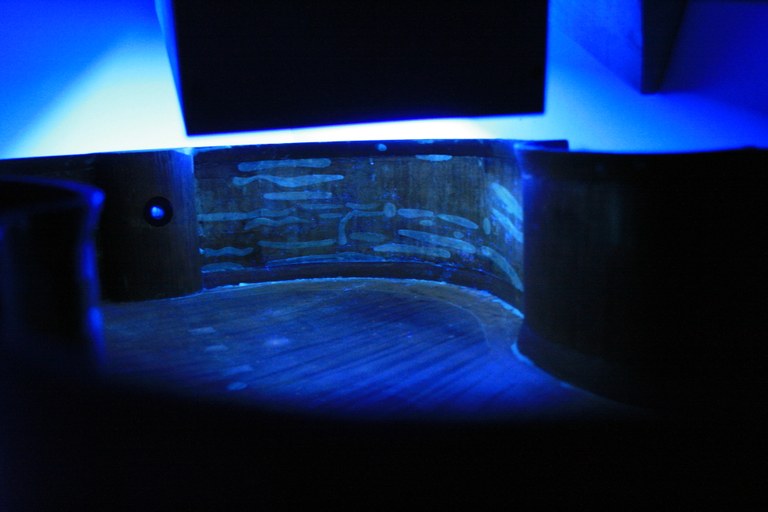
Fig. 7: The same bottom ribs as shown in Fig. 6 in UV light. The parchment covers are clearly visible.
A hole punch with a diameter of 10 mm is suitable for the restoration of violins, and 12 mm punch holes are preferred for cellos because of the thicker belly. To cover areas where circular cracks are unsuitable, such as the F-hole balls, the ribs or the edge areas of the belly and back, the author cuts with a knife (carving knife steel in the quality usual in violin construction) rounded shapes into the parchment. The smooth side of the parchment pointing upwards. The rounded shapes prevent damage and detachment of the crack covers (Fig. 6 + 7). For gluing the covers, the author applies warm, liquid hide glue to the rough side of the covers immediately before application and places the covers on the previously defined location. It is sufficient to press the covers with the fingertip and remove the excess glue with a warm-moist brush, this also serves to moisten the surface of the cover as intended.
The contact between the wood and the cover occurs when the cover is dry and any liquid under the cover has evaporated. It is not necessary to use clamps, as is customary when using wooden crack covers.
A series of experiments
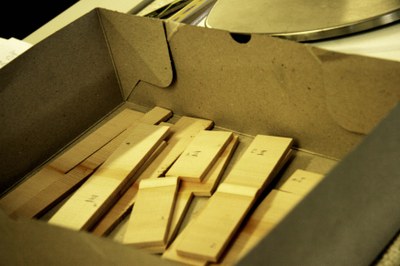 The questions aros
The questions aros
(a) if crack covers provide a higher degree of reliability than uncovered cracks?
(b) if parchment covers provide similar protection to wooden covers?
To evaluate this, the authors conducted a series of experiments. As a test object four grooved wooden test boards, made from 15-year-old spruce tonewood, were used. The joints were glued with warm hide glue, which is widely used in violin restoration. In the samples the growth rings were quarter sawn short grain (parallel to the joint).Three boards of 140 mm in length, 30 mm in width and 4.9 mm in thickness are prepared from the same grooved board, one is not covered, the other is covered with a 0.1 mm thick parchment cover, the third with one wooden cover of thickness 1,4 mm.
In order to make a precise statement about the maximum stresses up to the failure of the sample, tensile tests were carried out in accordance with DIN 52188. For the load application speed, 0.5 mm / min was selected. While under load, the samples failed after about 1.5 minutes. This slow breaking time is ideal for this type of examination as it permits more accurate measurements.
 In principle, the experiment was aimed at determining the maximum stresses across the repaired crack in the belly until a voltage drop is seen, this signifies failure of the sample. The four test runs were carried out according to exactly the same criteria. Wood, and to a lesser degree parchment are not homogeneous materials. The quality of the joint can also fluctuate and so with a higher the number of samples, the higher the level of significance of the tests.
In principle, the experiment was aimed at determining the maximum stresses across the repaired crack in the belly until a voltage drop is seen, this signifies failure of the sample. The four test runs were carried out according to exactly the same criteria. Wood, and to a lesser degree parchment are not homogeneous materials. The quality of the joint can also fluctuate and so with a higher the number of samples, the higher the level of significance of the tests.
In a preliminary test, the density was determined in a dry state. The procedure according to ÖNorm EN 13183-1: 2004 was followed. An average density of 407 kg / m2 could be determined. During these preliminary investigations, the mass of a single wood cover and of a single parchment cover were determined. This showed values of 0.09 grams for a diamond-shaped wood cover with an edge length of 22 mm and 10 mm and a thickness of 1.5 mm. The parchment covers, showed a mass of 0.019 grams with a diameter of 12 mm and a thickness of approx. 0.1 mm.
In order to ensure the reproducibility of the tensile specimens, samples were conditioned in the standard climate of 20 ° C. and 65% humidity. After a specified time, the compensation moisture of the wood was measured.
Construction and execution of the tensile test
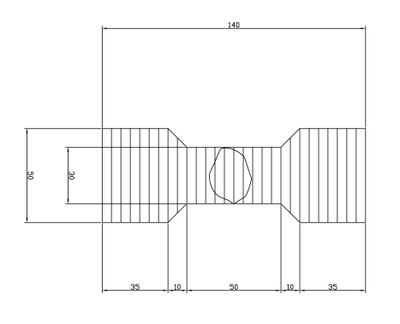
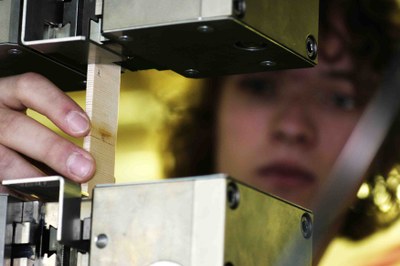
Left picture: Fig. 8a / right picture: Fig. 8b: Performing the tensile test.
The sample board is clamped between two metal tongues so that the grooved area is in the middle of the two tongs. The experimental setup is illustrated in Fig. 8 a + b.
An uncovered joint was tested in direct comparison to a joint with a wooden cover, and a joint with a parchment cover. The voltage profile and the failure of the samples are documented in the diagrams 1 to 4. Table 1 shows the points at which the tensile specimens failed.
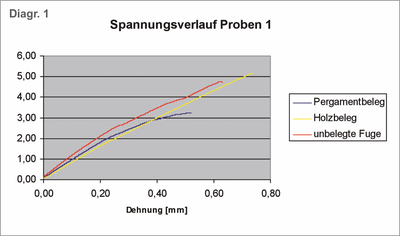
Diagram 1: The cracking of the parchment covered wood above the joint at a low tension can be traced back to a weak point in the wood.
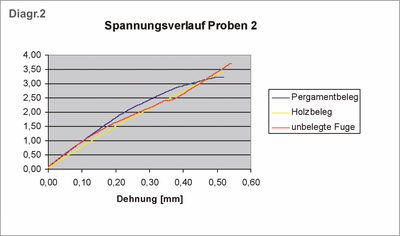
Diagram 2: All three specimens are torn at about the same tension, but only the parchment cover could prevent cracking of the joint.
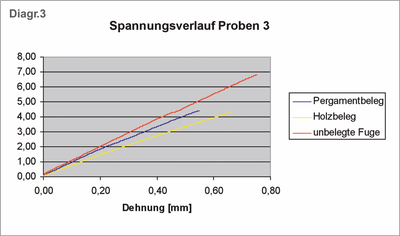
Diagram 3: The pieces of wood covered with wood and parchment tore at a weak point in the wood above and below the covers.
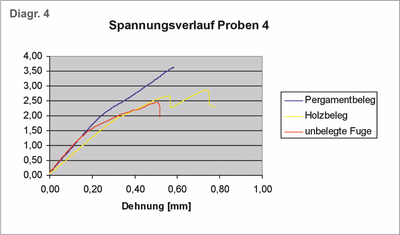
Diagram 4: Only the parchment cover saved the joint. The two-step failure of the sample can be clearly seen with the help of the value for the wood cover. This means that the wood cover failed at an extension of 0.55 mm, and the belly with an extension of 0.65 mm (Fig. 9).
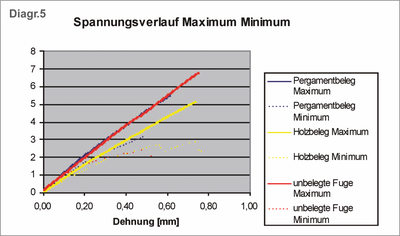
Diagram 5: The minimum and maximum values of the four samples show that both the wood covered joint (with a range of 2.29 N/mm2 to 5.71 N/mm2), and the uncovered joint (with a range of 2.00 N / mm2 to 6.80 N / mm2) are unreliable, as opposed to the parchment covered joint (with a range of 3.62 N / mm2 to 5.53 N / mm2). These findings could be the result of the influence of the exertion of forces and the resulting shearing in the glue joint. Due to the significantly lower thickness of the parchment covering of 0.1 mm compared to the 1.4 mm of a wood covering, the eccentricity of the force transfer is significantly lower. Therefore, a lower bending moment is introduced and the resulting shearing of the glue joint is also clearly reduced.
Final Conclusions
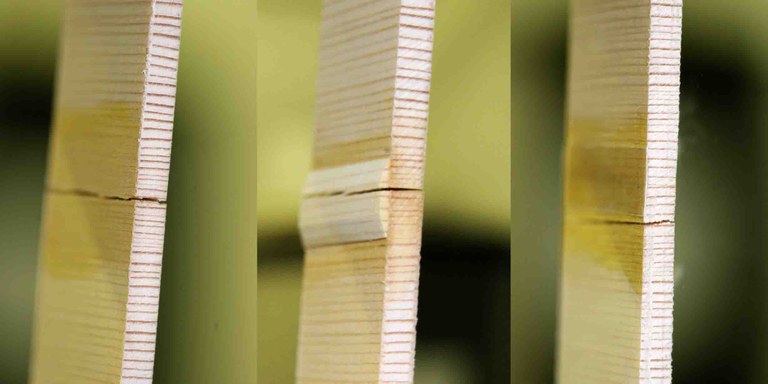
Fig. 9: The left sample, the uncovered crack is torn in the area of the joint. The middle sample, the wooden covered joint, cracked on the joint and on the wooden cover. The right sample, the parchment covered joint cracked underneath the joint and the parchment cover (sample 4).
The following findings can be gained from the test evaluations:
Parchment covers have superior properties compared to the wooden covers. A parchment cover holds a maximum voltage that is about seven percent higher. Furthermore renewed failure of the cracked location is reliably prevented. The covered crack can be considered as stable as a non-damaged area. The two-stage failure of the wooden cover creates two problems: firstly, the repaired area is no longer secured, and secondly, parasitic noises can result from a torn wooden cover.
The limits of crack repairing with parchment crack covers
The upper limit of using parchment covers is reached at an area of about 2 cm2, since the forces that arise during gluing the parchment are so high that the wood is deformed even with a parchment thickness of less than 0.12 mm. In these cases it is possible to use sheets of silk or linen as these are used mainly during restorations of ribs.
In spite of the advantages of parchment coverings, it is absolutely necessary to assess the replacement of wooden coverings in individual cases. In the restoration example documented in Figures 4 and 5, the author has kept two wooden covers after thorough examination. These covers relate to areas which should not be altered: two cracks running under the bass bars. This woodcut, which is important for the sound emission and is fitted into the belly, should not be changed in any way during this restoration, since the cello with this bass beam is outstanding.
Even when repairing a crack running under the bass bar, the bass bar is to be covered with wood, since the parchment between the bass bar and the belly would be too risky due to the different behavior of the wood and the parchment. In this case, the bass bar must be adjusted to the previously set wooden cover.
Crack repair on the closed instrument
Parchment covers have proven to be a very good way to cover cracks on closed instruments. In this technique, the belly edge is detached only in the area in which the belly crack is located. This method is recommended if a small crack can be cleaned and clamped in this way. In this case, the complexity and scope of the intervention, which means a removal of the belly, is balanced against the disadvantage that excess glue cannot be removed from the interior.
For measurement, the interior of the instrument must be well lit, eg with an endoscope. A wire, which with a loop at the end, is bent in such a way that the intended place to be covered can be easily reached by one of the F-holes. To glue, the parchment cover is coated with glue on the inside, lightly moistened on the outside, placed on the loop of the heated wire, passed through the F-hole and placed on the previously defined location. It is enough to stick the cover with the wire. It is important not to use too much glue because the excess glue cannot be removed using this method. (The water-soluble animal glue could, however, be easily removed when the instrument is opened at a later date, which ensures the reversibility of the procedure.)
The restoration of the Italian cello from the 18th century

Fig. 10: The owner with his restored 18th century Italian cello.
The restoration project of the Italian cello was a great success. The musician and owner of the cello Ulrich Fuchs (note 10) noted:
"When restoring my already very good sounding instrument, initially, the priority was to remove a more recent lacquer covering to reveal the original lacquer as gently as possible. However, it soon became clear that on this occasion, all open crack should be repaired. The result of the restoration is simply sensational. The cello is much louder, is even more balanced, because the A-string has gained, speaks better and has more sound colors than before. I have never seen an instrument so improved in sound after repair."(Ulrich Fuchs)
Additive
Since 2017 we have included parchment covers (10mm) for violins and parchment covers (12mm) for cellos in our online shop. The ready-to-use parchment covers from SCHILBACH bring high time-saving and allow uncomplicated work.
Remarks
Translated from German by Dr. Katy Stevens.
- Note on an article on a similar topic: Christian Rault, An exploration of some restauration techniques, in: Strad Magazine, vol.102, n° 1210, Londres, february 1991, pp. 144–149
- Quelle: Simone F. Sacconi, Die Geheimnisse Stradivaris, Verlag Erwin Bochinsky, Bergkirchen 1981, S. 49
- Pergamentbelege in der Restaurierung von Streichinstrumenten
http://www.restauro.de/Hefte.html -
Tilman Gruenewald
tgruenewald.htb-b2007@fh-salzburg.ac.at
